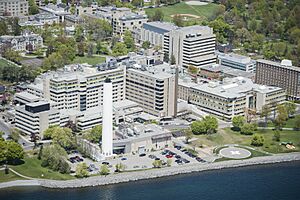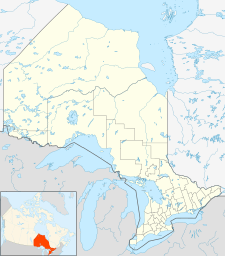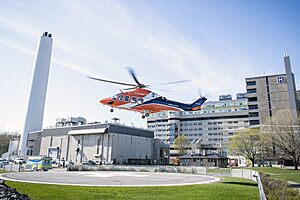Kingston General Hospital facts for kids
Quick facts for kids Kingston General Hospital |
|
|---|---|
 |
|
| Geography | |
| Location | 76 Stuart Street, Kingston, Ontario, Canada |
| Coordinates | 44°13′27″N 076°29′35″W / 44.22417°N 76.49306°W |
| Organization | |
| Care system | Public Medicare (OHIP) |
| Hospital type | Acute care |
| Affiliated university | Queen's School of Medicine |
| Services | |
| Emergency department | Yes, Level II Trauma Center |
| Helipad | (TC LID: CPJ7) |
| Beds | 500+ |
| History | |
| Founded | 1835 |
The Kingston General Hospital (KGH) is a major hospital in Kingston, Ontario, Canada. It's a special kind of hospital called a teaching hospital, which means it works closely with Queen's University to train new doctors and nurses.
KGH is part of the Kingston Health Sciences Centre, along with the Hotel Dieu Hospital. Together, they provide health care for over 500,000 people in southeastern Ontario. They also do important health research and help educate future health care workers. KGH is the oldest public hospital in Canada that is still open today. Many of its original buildings are still standing. Because of its long history and unique architecture, KGH was named a National Historic Site of Canada in 1995.
Contents
A Look Back: The History of KGH
How KGH Started in the 1800s
In 1832, a special group was formed to plan and build a hospital in Kingston. The first building was finished in 1835 on land bought from Archdeacon George O'Kill Stuart. This building was designed to hold 72 patients.
However, the hospital didn't open right away. It took three more years for the city to get enough money for equipment. In 1838, the hospital briefly took in its first patients. These were twenty wounded Americans captured during the Rebellion of 1837.
KGH as Parliament House
When Kingston became the capital of Canada in 1841, the government needed a place to meet. The hospital building was chosen to be the first house of Parliament. Lawmakers met there from 1841 until 1844. Then, the capital moved to Montreal. In 1845, the building went back to being a hospital. Thanks to the Female Benevolent Society, it began helping people each year.
Remembering the Irish Immigrants
The hospital grounds also hold a sad part of history. About 1,400 Irish immigrants died in Kingston during the typhus epidemic of 1847. They were fleeing the Great Famine in Ireland and had been housed in "fever sheds" along the waterfront. Some of their remains were moved to St. Mary's Cemetery in 1966. Work to move most of the other remains began in 2021.
Growing and Helping More People
At first, the hospital had only a housekeeper-nurse and an assistant. Later, a house surgeon and caretaker also lived there. Volunteers from the Female Benevolent Society helped out, and local doctors offered their services for free. Until the 1900s, the hospital mainly cared for poor people and new immigrants.
In 1854, KGH started working with the Queen's School of Medicine. This helped train future doctors. The Watkins Wing opened in 1863 to treat patients with infectious diseases. This addition was funded by local businessman John Watkins.
In 1886, a surgeon named Kenneth Fenwick helped start a training program for nurses at the hospital. This was important for having skilled nurses. The Nickle Wing, named after William Nickle, opened in 1891. It was built to keep patients with infectious diseases separate.
The Doran Building opened in 1894 for women, especially those having babies. This was funded by Michael Doran. In 1895, a surgical amphitheater (a special room for surgeries) was built. This was thanks to surgeon Kenneth Fenwick. It was a big step forward, especially with new discoveries like ether and chloroform for pain relief during surgery.
KGH in the 1900s
New Homes for Nurses and Community Help
In 1904, the Nurses' Home opened. It was later named after Ann Baillie. This building was needed because nursing was becoming a bigger and more important job.
In 1905, the hospital's Women's Aid group was formed. It had 110 members within a year. This group, now called the KGH Auxiliary, was one of the first of its kind in Ontario. These women quickly started raising money for the hospital. Their efforts helped fund the Empire Wing, built in 1914. This wing offered more private rooms for patients who could pay. Even though KGH still helped those in need, more people from the community started coming to the hospital for care.
Changes in Leadership and Services
In 1924, KGH had some problems with its staff and management. The hospital decided to hire someone with a business background, not a medical one, to run things. In 1925, R. Fraser Armstrong, a civil engineer, became the superintendent. He stayed in this role until 1957.
As the need for tests and diagnoses grew, the Richardson Laboratories and Douglas Wing were built in 1925. During the Great Depression, Armstrong created Ontario's first public health insurance plan. This plan helped people pay for hospital care.
In 1932, all hospital staff donated five percent of their salaries to help the hospital during the Depression. In 1947, the Victory Wing was completed. It had beds for patients from Veterans Affairs Canada and also housed the Ontario Cancer Foundation.
Expanding Care for Children and More
The Angada Children's Hospital opened in 1953. The name "Angada" means "to bring help unto you" in Arabic. This name was chosen because the Shriners gave a lot of money to build it.
In 1960, the Walter T. Connell Wing was built. It was named after a long-time head of the Department of Medicine at KGH. Two more floors were added to this wing in 1970.
The Fraser Armstrong Patient Centre opened in 1975, offering many outpatient clinics. An emergency department followed in 1976. In 1977, the Ronald C. Burr Wing opened, providing regional rehabilitation services.
In 1981, the T. Ashmore Kidd Wing opened with a new operating room and facilities for medical records and radiology. Three years later, renovations added new labs, ophthalmology (eye care), prosthetics, endoscopy, a kidney unit, and a lung function lab.
The Syl and Molly Apps Medical Research Centre opened in 1987. It was named after a famous Kingston couple known for helping the community. The Kidd/Davies Patient Tower and a new main entrance opened in 1989. This new wing included a neonatal intensive-care unit (for sick newborns), a kidney unit, and heart services.
In 1994, new magnetic resonance imaging (MRI) equipment was installed at KGH. This made Kingston one of Ontario's main centers for advanced medical imaging. Major renovations to floors 9 and 10 of the Connell Wing were finished in 1995. The Same Day Admission Centre was built in 1997, and the Emergency Services area was renovated in 1998.
KGH in the 2000s: Modernizing Care
Major renovations to the Syl and Molly Apps wing happened in 2002. Parts of the emergency department were updated and opened in 2003. In 2004, the Kingston Regional Cancer Centre joined KGH and became Cancer Care South East at KGH.
A new MRI machine was installed in 2005. In 2009, two new floors were added to the Kidd Wing. The Cancer Centre in the Burr Wing also had a big expansion. Many outpatient clinics moved to Hotel Dieu Hospital. This allowed KGH to focus on being the main hospital for serious, acute care in the region.
Focusing on Patients and Research
In 2008, KGH started focusing on "patient and family-centered care." This means making sure patients and their families are involved in their care. KGH was one of the first hospitals in Canada to do this, and it received many awards.
The Kingston General Hospital Research Institute (KGHRI) started in 2010. Its goal is to create new knowledge that helps patients, families, and the medical community. The institute works with other Kingston hospitals and Queen's University.
The Research Institute is building the W.J. Henderson Centre. This new space will bring together scientists, treatment teams, patients, and families for research. It will have labs that different research teams can share. It will also have patient-friendly areas for overnight studies and clinical trials.
Joining Forces for Better Care
In April 2017, Kingston General Hospital and Hotel Dieu Hospital officially joined together. They became one organization called Kingston Health Sciences Centre. The new President and CEO, Dr. David Pichora, said this would help them use their resources better. It would also give communities more access to different health services close to home.
Also in 2017, a new medical treatment was performed at Kingston Health Sciences Centre. It was a "hybrid ablation" for atrial fibrillation (a heart rhythm problem). This was the first time this treatment was done in Canada. KGH is known worldwide for its excellent cardiac care.
What Services Does KGH Offer?
KGH offers many important medical services. Here are some of them:
- Cardiac care (heart health)
- Critical care (for very sick patients)
- Emergency care (for urgent medical needs)
- Domestic violence support
- Mental health support
- Nephrology (kidney care)
- Oncology (cancer care)
- Pediatrics (children's health)
- Obstetrics and gynaecology (care for pregnant women and women's health)
- Pathology and molecular medicine (studying diseases)
- Surgery, perioperative (before, during, and after surgery), and anesthesiology (pain management during surgery)
- Acute General Internal Medicine (care for various serious medical conditions)
- Neuroscience|Neurosurgery|EMU (brain and nervous system care)
- KHSC@Home (home care services)
Special Clinics at KGH
KGH also has many specialized clinics:
- Cardiac Rhythm Device (for heart rhythm devices)
- Diagnostic radiology (X-rays, scans)
- EEG (brain wave tests)
- Endocrinology and Metabolism (hormone and body process care)
- Gastroenterology (digestive system care)
- Infection control
- Regional Stroke Program (care for stroke patients)
- Rheumatology (joint and muscle disease care)
- Sleep lab (for sleep problems)
Heliport
The hospital has a heliport, which is a landing pad for helicopters. It's on the ground level, on the south side of King Street West, facing the water. When an air ambulance lands, patients are then transferred by ground ambulance to the hospital building across the street.
More to Explore
- Hotel Dieu Hospital site
- Providence Care Hospital
- Museum of Health Care



